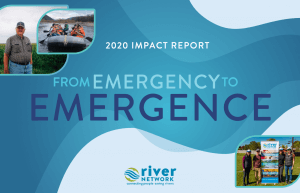River Network’s History and Equity, Diversity, Inclusion Journey
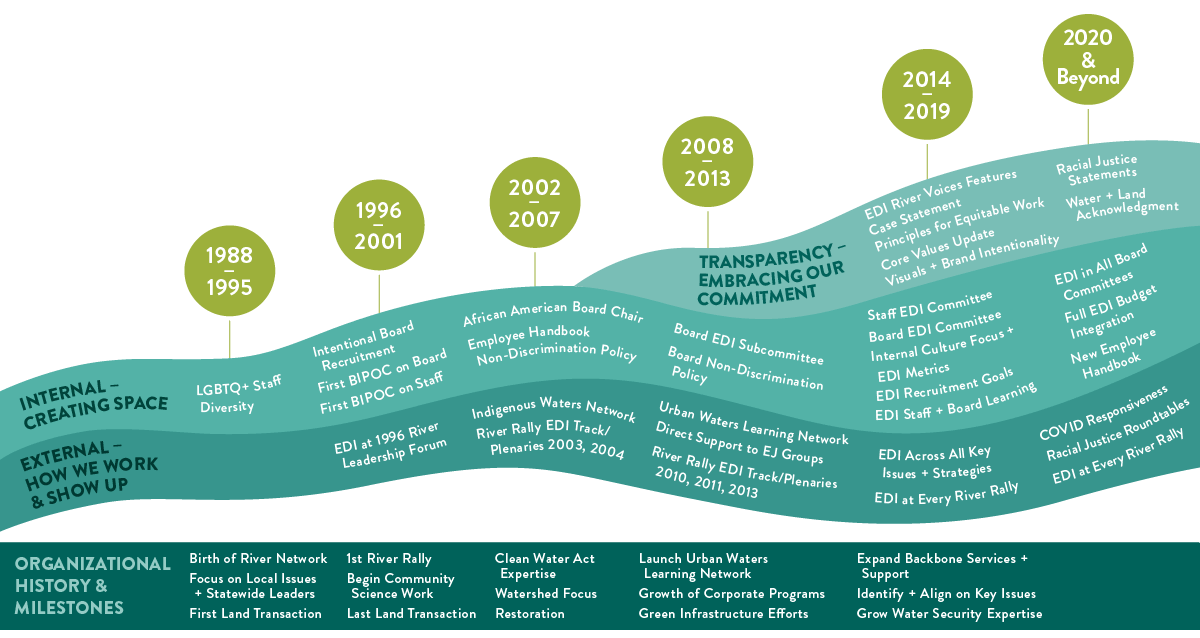
As a backbone to the national network of water protectors, River Network has a unique role to play to influence water leaders from coast to coast to become more equitable, our organizations more diverse, and our practices and solutions more inclusive. Given the changing demographics of our nation, we believe that to remain socially relevant and to expand our impact, the work of this network and its workforce must evolve.
We strive to be a change agent both by modeling what we must do internally, integrating a focus on challenges at the intersection of equity and water throughout our work, and helping members of our national network begin their own journeys related to equity, diversity, and inclusion (EDI). Note that we have intentionally flipped the order of the initials in this acronym. We did so because of the importance of beginning with the reality that access to healthy rivers and clean water—as well as protection from harm caused by floods and droughts—is not equitable.
We also realize that this change must begin from within and that it is not linear. In reflecting with staff and board members past and present, we see places where we’ve built strong muscle, as well as times when times we’ve lost it, regained it, and lost it again. We invite you to explore this with us below, where you’ll find major milestones in…
- Our organizational history.
- The external, how we work and show up.
- The internal, creating space for EDI.
- Transparency, embracing our commitments.
Here, we humbly share our history and journey, acknowledging where we’ve not done enough, how much work is still ahead, and the ways in which the internal and external work overlaps and informs the other. We hope this inspires and encourages others across the network to begin, renew, and accelerate efforts to build a more diverse and inclusive movement for our nation’s waters.
For video captions in English or Spanish, please click the gear icon within the YouTube player.
Organizational History
-
1988
1988 - Beginnings
River Network was founded in 1988 to help people save rivers and their watersheds. At the time, there were about 200 state and local watershed protection groups around the US, but thousands of watersheds where there was no group at all. We saw both a great need for more groups and the enormous potential of their collective impact. We saw two roles to play: citizen organizing and land acquisition.
“When you looked at well cared for rivers, it was because people were deeply involved. If there wasn’t a constituency using and enjoying the river, they were dredged, channeled… The fundamental intuition of River Network was that you can’t have quality without a dedicated constituency. River protection wouldn’t go anywhere unless valley by valley there were local groups that cared.”
-Phil Wallin, River Network Founder
-
1989
1989 - The First Land Transaction
Newly formed, River Network negotiated the purchase of a 7,200-acre refuge for elk and deer within Hells Canyon National Recreation Area on the Snake River at the Oregon/Idaho border. This purchase kicked off a partnership with the Hells Canyon Preservation Council, formed to help them preserve the area’s land and water resources.
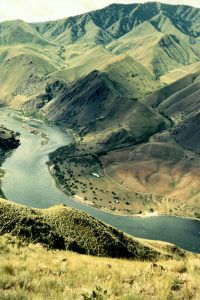
Cache Creek, within the Hells Canyon National Recreation Area. Courtesy Phil Wallin.
-
1992
1992 - Finding Financial Footing
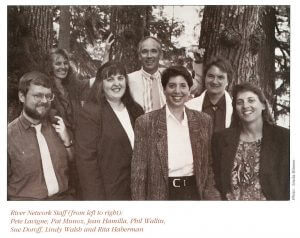
Staff photo from River Network’s 1993 Annual Report.
After getting by for the first two years on foundation grants, revenues declined precipitously leading to a significant reduction of staff and an increase in obligations for the single remaining position.
“We were running as fast as we could to stay in the same place. Every morning I worked on the land [transactions] program; every afternoon I worked to put out the newsletter with something valuable for the folks out there protecting [their rivers].”
-Phil Wallin
To address the funding decline, land protection efforts grew, and as revenue from these transactions rose, River Network was able to rehire staff and expand the land transaction program by hiring Sue Doroff.
-
1993
1993 - Membership & Room to Do More
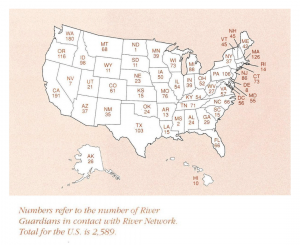
One of the first membership maps, from our 1993 Annual Report.
The first iteration of River Network membership launched in 1993, formally connecting grassroots, state, regional, and national watershed conservation organizations for the first time. To gauge how to best serve these groups and learn their needs and priorities, River Network conducted its second network-wide survey. Notably, neither this nor a previous 1990 survey included questions on diversity. The network as a whole was still, as Wallin puts it, “overcoming that heritage,” of the white, male-dominated conservation space in the United States and insular network of river insiders.
“[Early on,] we didn’t do a great job [on inclusion], but it’s a story of progress.”
–Phil Wallin
-
1994
1994 - From Rivers to Watersheds
By 1994, River Network had hit its stride with land transactions. As the organization was no longer struggling to stay solvent, new ideas had room to emerge. For example, River Network co-founder, trustee, and former American Rivers President Kevin Coyle encouraged shifting the organization’s thinking – not just about rivers but about water on the whole, noting the difficulty of changing “river policy” without first changing “water policy.” With a focus on water quality and supply, protection at the watershed level came into focus. This approach was further championed by staff like Pete Lavigne, who joined River Network in 1992, and representatives from grassroots groups newly connected through the River Network Partnership, like Don Elder. (Don would later join the River Network staff and serve as Executive Director.)
“Organizing at the watershed scale forces us to see the big picture; equity, justice, safety, access to natural areas.”
-Don Elder, then Executive Director of Alabama Rivers Alliance
The thinking on who we served also began to expand through this lens.
“The hundreds of thousands of citizens who participate in river conservation... are not just anglers or boaters. They are professors and city planners, engineers and lawyers, farmers and ranchers, and Native American Tribes. Increasingly they are urban people who are involved in river greenways and creek restoration. Often, they are the poor, both urban and rural, who bear the brunt of watershed deterioration.”
-River Network 1994 Annual Report
Read more on the watershed approach in River Voices Summer 1995.
-
1999
1999 - Teaching the Clean Water Act
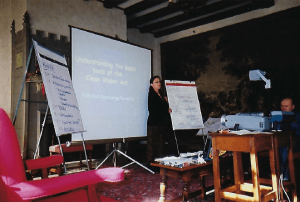
Gayle Killam conducting a Clean Water Act training. Courtesy Gayle Killam.
River Network’s Clean Water Act (CWA) training program grew out of the recognition that law and policy training was essential for local groups. These groups often knew the laws weren’t working properly in their watersheds, but they lacked the knowledge as to what to do next in response.
Equity was the principle by which we got involved in the Clean Water Act. Don Elder, in doing this work at the local level in Alabama before joining River Network in 1996, realized just how many assumptions go into allowable toxin level calculations under the CWA for fishable, swimmable waters. Whether it was the number of ounces of fish the “average” person eats, which assumed a Western diet and doesn’t account for subsistence fishing, or the “average” weight of a person, which assumes an adult white male and didn’t accurately protect women and children, Elder and other River Network staff saw that when we go about building policies this way, the “default” setting often doesn’t protect everyone or account for disparities in how the effects of pollution play out at different economic levels or across races. Educating local leaders on these issues—and empowering them to train others—became a cornerstone of our work for decades and was supplemented with the Clean Water Act Owner’s Manual, first published in 1999, the same year our trainings began.
Read more from Gayle Killam on River Network’s impact with the Clean Water Act.
-
1999
1999 - Merger with River Watch Network
After working closely together since 1997, River Network merged with River Watch Network, a national leader in teaching people how to assess and monitor the health of their rivers. Through previous collaborations, we realized how productively our programs fit together: each of us brought an important and distinct approach to river conservation that was in high-demand from groups around the nation.
In merging, we found we could design and deliver services more powerfully together than separately, with the goal of stimulating more and better watershed monitoring and assessment activities in more of the nation’s watersheds. The resulting River Watch program would empower community-based monitoring across the country for years to come.
-
2002
2002 - Spinoffs, Separation
The early 2000s brought uncertainty at the national level, both through the financial recession, and the horrific events of 9/11. River Network was no exception to this uncertainty. For 15 years, the land transactions arm of River Network had continued to grow, both in terms of the scale and complexity of its projects, and its national reputation. It became clear that an operation of this magnitude would benefit from its own governance and administration, and so in 2002, Western Rivers Conservancy was launched, with Phil Wallin at its helm.
-
2014
2014 - Expanding Focus
Beginning in 2014, River Network expanded its focus from water quality and strong champions to also include water security, while also digging deeper into our role as a backbone organization connecting water protectors and advocates. In short, River Network reinvested in its unique value proposition informed by network-wide needs. With a sharper focus on strategic direction, River Network’s financial outlook stabilized and the organization began to grow slowly and deliberately, including at the intersection of equity and water.
“To achieve a future with healthy rivers and clean water for all, we must build a more diverse and inclusive movement for our nation’s waters. It is time to evolve.”
-Nicole Silk, River Network President
-
2018
2018 - The Key Issues and a New Strategic Plan
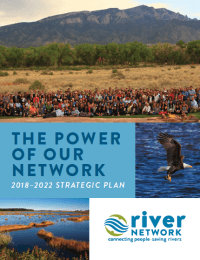
In 2018, River Network identified four water-specific key issues to align our work and achieve greater collective action, issues that are relevant to each region, impacted by climate change, and challenged by unique inequities: safe, clean, affordable drinking water; resilient cities and communities; healthy rivers in agricultural landscapes; and water law and policy. For these areas, River Network delivers tools, training, and resources to those making a difference at the local level and brings the power of the network together for greater impact at larger scales.
-
2020
2020 - Pandemic Response
Just a few months into 2020, the COVID-19 pandemic brought our work and our outlook to a sudden stop. Instead of becoming paralyzed by uncertainty, River Network moved swiftly. We adapted our programs and projects, creating spaces for dialogue and exchange for our nation-wide community. In just six weeks, we transformed River Rally into a virtual experience, delivering hope and inspiration for our highest registration and most diverse audience ever. Our creativity and innovation continued as we created the go-to platform to address water shutoff threats and protect access to clean and affordable drinking water, deepened our partnerships with local conservation groups and the agricultural sector to ensure a future with farms, ranches, and healthy rivers, returned power to communities to build a future of their own design by lifting up local leaders to look at urban resilience in new ways, and built capacity and supported staff and volunteer persistence for civic engagement and water policy.
External Impact
-
1996
1996 - EDI at the River Leadership Forum
At the second River Leadership Forum, River Network brought together 22 leaders of state and large basin organizations in Capon Springs, WV. The group focused on multiple organizational development topics and techniques for getting the message across to the public about clean water and healthy rivers. Those in attendance also participated in a powerful session on equity, diversity, and inclusion.
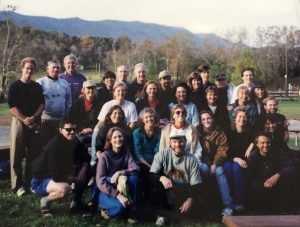
Attendees at the River Leadership Forum. Photo courtesy Phil Wallin.
“I remember it very vividly, we were all in tears. One participant, a person of color, pushed us, saying ‘you need to know how I feel in this group, you need to know how I feel in this movement.’”
-Suzi Wilkins-Berl, River Network Board Member Emerita
-
2001
2001 - Engaging with Tribes
Ken Margolis‘s strong relationships with tribal partners and experience with coalition building, coupled with River Watch Network’s work with tribes from the Northeast to the Southwest led to an increase in our overall work with tribes, especially around water monitoring and the Clean Water Act.
“We were getting more involved in Lake Champlain and its northern tributaries, looking at mercury levels. Most significantly affected were the Abenaki, who have a presence in the area and who rely heavily on fish from the lake as a food source. We were able to get a handle on their exposure and risk and help them minimize it. When the Rio Grande work started, we were working with people on the Mexican side of the river who were being taken advantage of as cheap labor, health disparities, and other issues. There was a recognition that we could apply the River Watch model in communities that were at higher risk, and this led to us to more explicitly serve disadvantaged and vulnerable groups at the local level.”
-Jack Byrne, former director of River Watch Network, prior to River Network merger
Building on this work, 2001 saw the creation of the Tribal Services Program to continue serving tribal governments and coalitions in developing long-term program goals, community health surveys, and water monitoring methods.
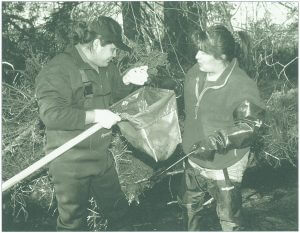
Taos Pueblo environmental staff participate in a River Watch training. River Network photo.
-
2002
2002 - Indigenous Waters Network
Building on previous tribal engagement, River Network helped launch and facilitated early discussions of the Indigenous Waters Network meant to identify solutions to water quantity and quality threats facing tribal communities across the US. With funding from US EPA, this tribal caucus discussed topics ranging from water sovereignty to implementing the Clean Water Act on tribal lands, as well as other issues. River Rally proved to be an important annual gathering for the tribal caucus, and played a significant role in broadening participant demographics: up to one third of Rally participants in this era identifying as Black, Indigenous, and/or person of color.
-
2003
2003 - Making the Public Health Connection

River Rally 2003 Program.
Recognizing the disproportionate impacts faced by low income and disadvantaged communities related to water pollution, River Network initiated the Healthy Waters, Healthy Communities Program. Led by Steve Dickens and other staff, the program was designed to help communities with health concerns determine whether there was a link between pollution and health problems they were experiencing, and if so, what to do. It was also designed to empower grassroots organizations to effect meaningful environmental change through technical and organizational assistance. To this end, River Rally 2003 included a new workshop track: Human Health & Environmental Justice.
“I was amazed to see what Steve was doing in these communities… teaching them how, through community science, to tell that their water was polluted and what to do about it.”
-Wendy Wilson, then River Network Organizational Development Director
This program led to a continued focus on public health and its impacts for racial and environmental equity, as well as River Network publications like Cancer Downstream, published in 2007.
-
2005
2005 - Connection in the Gulf
Following the devastating impacts of Hurricane Katrina, we established a Gulf Coast Watershed Recovery Fund to help local groups rebound. We built on this work in the Gulf in 2010, when River Network facilitated early conversations between frontline communities, environmental organizations, fishermen’s associations, and others in the wake of the BP Oil Disaster. This led to the formation of the Gulf Future Coalition.
-
2006
2006 - Creating Space for Climate Equity
In Don Elder’s time as President, from 2003 to 2008, he became increasingly convinced that river and watershed groups had a role to play in climate protection. At River Rally 2006, his opening remarks focused on the climate and water connection.
“We should not think of ourselves as groups that work on water only… We are working on a wide range of related environmental, economic, social, and moral issues. We should add climate change to the list.”
-Don Elder
These remarks were well-received by the network, generating both interest in and funding to support climate work and align it with equity issues. Elder saw firsthand how infrastructure investments were encouraging, allowing, and even subsidizing white flight, while living in the South for a period of time. This enabled him to make the connection at the watershed level, and he became convinced that climate protection—with an eye on efficiency and equity—should be an aspect of our work in every watershed of the country.
-
2011
2011 - River Rally 2011 in Charleston, SC
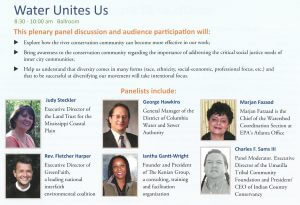
River Rally 2011 Program.
In 2011, diversity and environmental justice took center stage in River Rally programming more than they had in previous years. For example, the “Water Unites Us” plenary panel discussed how to diversify the work of the conservation community and understand social justice needs, and it looked at the many different forms of diversity. Rally also featured the workshop theme “Rivers & Human Health/Environmental Justice,” bringing focus back to these topics, which was first introduced as a workshop track in 2003.
-
2012
2012 - Prioritizing Urban Waters
Since 2012, River Network has supported efforts to restore urban waters and the communities around them–many of which have seen decades of disinvestment–through the Urban Waters Learning Network (UWLN). UWLN grew out of the idea that a grant program could to a lot more than simply fund a handful of projects on the ground – it could help leaders working to restore their urban waters in communities across the country learn from one another and build the skills and connections needed for success through peer-to-peer networking. Originally made up of 10 communities, the UWLN has grown to nearly 200 organizations, agencies, local units of government, and academic institutions. We partner with Groundwork USA in coordinating the Learning Network, providing support and opportunities for members to share successes, challenges, and technical resources.
“Because of the networking opportunities the UWLN provides, we’ve seen leaders learn from each other and replicate projects that were successful in another corner of the country – whether it’s launching a rural-urban youth internship program, deploying devices to capture trash in local waterways, or engaging community members in planning for communities that are more resilient to climate threats. River Network has also benefited from this exchange – as the membership of the UWLN has grown, so has the depth of our own understanding of the issues that contribute to healthy urban waterways and thriving communities.”
-Diana Toledo, River Network Leadership Development Director
-
2014
2014 - Flint & The Network
In 2014 as the Flint water crisis unfolded, water organizations in the Great Lakes and beyond, including River Network, had to face hard questions. As a people-centric organization with a mission to help watershed groups build their skills, why weren’t we doing more to support groups in Flint and other places struggling with access to clean, safe, and affordable drinking water?
“I felt like River Network had this great potential. I’d been to River Rally. I saw the community, I really respected the knowledge, the skill building. And on the other hand, they were completely absent from what was the biggest water moment of the decade.”
-Jumana Vasi, River Network Board Member and former program officer at CS Mott Foundation
We began soul searching. It would take a few years (read more about this period and the evolution of the Board Diversity Working Group in our Internal timeline below), but by the release of our 2018-2022 Strategic Plan, drinking water emerged as one of the four key issues that guide River Network’s programming, we hired staff dedicated to drinking water work, and we regularly convene peer cohorts and discussions to share learnings and empower local leaders, including those still fighting in Flint.
-
2016
2016 - River Rally 2016 in Mobile, AL
As part of the Board Diversity Working Group’s efforts, River Rally 2016 included a new theme, Diversity & Inclusiveness, along with a plenary panel, “Diversity and Inclusiveness: Transforming Ourselves and Our Work.” This River Rally would be a turning point for River Network: we found ourselves receiving feedback from both ends of the spectrum. Some attendees thought this was all it was too much too fast, with some walking out of the plenary. Others were vocal in their wonderment on why we weren’t pushing harder and sharing even more of our internal work publicly. Once again, we were pushed to truly take a stand – choosing to stand for equity, diversity, and inclusion for all and committing to sharing and learning publicly.
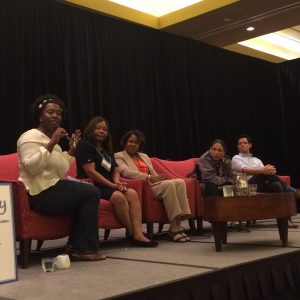
Speakers during the River Rally 2016 plenary. River Network photo.
“The Board Diversity Working Group pushed hard for diversity, equity, and inclusion to be a River Rally “theme” in 2016. However, the more important work was in helping River Network and the movement understand that DEI is more than a theme, it is a strategic way of functioning as an organization and should be mainstreamed, into every River Rally, underlying its design and gathering.”
– Baljit Wadhwa, past River Network Board Member
Read Nicole Silk’s opening remarks from River Rally 2016, and reflections on Rally 2016 learnings on the Urban Waters Learning Network blog.
-
2016
2016 - Trends Report: Our Water, Our Future
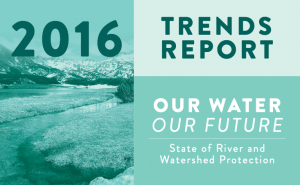
The 2016 trends report, Our Water, Our Future: State of River and Watershed Protection outlined then-current conditions of waterways in the United States. It included opportunities and threats to water quality and quantity, and provided an analysis of the diversity of the workforce within the river and watershed protection community, finding that over 85% of river and watershed organizations reported workforce diversity at under 25%.
Read the 2016 Trends Report: Our Water Our Future and press release.
-
2017
2017 - Sharing Foundational Knowledge
In conjunction with sharing our own “why,” we worked with the Avarna Group to present a two-part webinar series, sponsored by the Urban Waters Learning Network and the Kresge Foundation. These webinars both shared some of our internal work and helped our staff and other groups in the network understand definitions, frameworks, and how to move forward with their own equity, diversity, and inclusion work. As a backbone organization, we knew that modeling and sharing our own path could help others get started.
Watch Part 1 of the webinar series above and find Part 2 here.
-
2017
2017 - Collaboration for Urban Flooding & Equity
With the goal of fostering more resilient communities, River Network launched the Urban Flooding and Equity for Vulnerable Communities Collaborative to support organizations working at the intersection of water, equity, and climate change. We provided funding, training, and networking support to organizations in Colorado, Georgia, New Mexico, Oregon, and Rhode Island. This group of states is engaging community members in identifying and documenting instances of localized flooding, proposing community-informed and -led solutions, and moving local decision-makers to support solutions that advance equitable outcomes.
“Tackling the issue of urban flooding requires advocates to both name and directly address the disproportionate risks faced by communities made vulnerable by historic disinvestments. It is complex work. The members of the Collaborative generously contributed their wisdom and experience to help each other find new ways to approach their thorniest issues.”
-Diana Toledo, River Network Leadership Development Director
Read more on this work in the April 2017 issue of River Voices.
-
2018
2018 - Listening to Network Leaders on River Rally
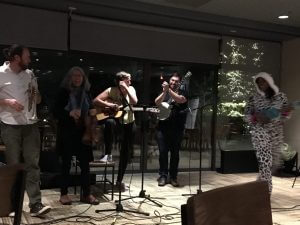
Rally 2018 attendees perform at the Open Mic.
River Rally 2018 brought another Rally first: we convened an ad hoc River Rally leaders of color committee made up of network leaders who made recommendations during the River Rally planning process for how to make the event more inclusive. From moving away from a talent show and towards an “open mic night” to recognizing more young leaders in our awards and creating affinity spaces for Black, Indigenous, and people of color, their recommendations can be seen in action at subsequent River Rallys.
-
2018- 2019
2018 - 2019 - Learning Publicly at River Rally
That same year, River Rally was held near the town of Lake Tahoe, CA. Though a beautiful site near the Truckee River, we did not account for the problematic nature of the resort’s name. Attendees, including many Native people, were understandably upset, and circulated a petition criticizing our staff and board for the choice. We chose to address this directly at the beginning of the Awards Celebration, offering an unqualified apology, owning the mistake and the harm it created, committing to do better, and thanking those who raised concerns for sharing their perspective and energy.
“We don’t defend. We apologize and we own it. In a way we modeled the behavior that we have been talking about for the rest of our community.”
-Nicole Silk, River Network President
The very next year, at River Rally in 2019 in Cleveland, River Hero James Rasmussen, executive director of the Duwamish Tribe Advisory Council, was not sure he would accept the award. Was River Network truly committed to serving the best interests of Black, Indigenous, and people of color? This again pushed forward many important discussions with River Network staff and board members in the lead up to the Awards Celebration. We once again committed deeply to our values, while giving Rasmussen the space and platform to publicly voice his conerns.
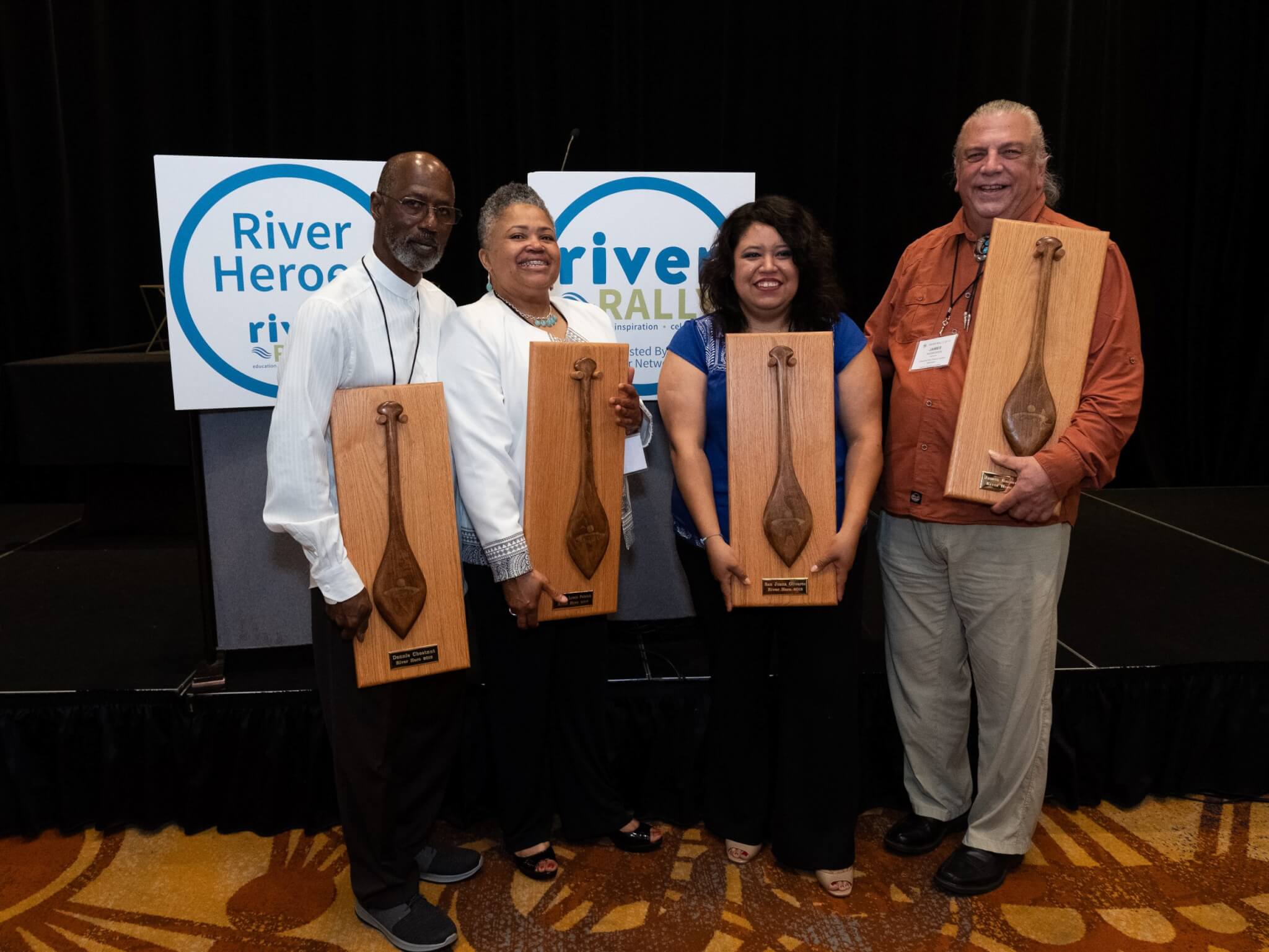
2019 River Heroes (L-R): Dennis Chestnut, Monica Lewis-Patrick, San Juana Olivares, James Rasmussen. Photo by Benjamin Colon
Read more in James Edward Mills’s piece, Beyond Equity – The 2019 River Rally.
-
2019
2019 - Lifting Up Network Voices
As the backbone for water protectors around the country, River Network is uniquely situated to amplify the voices of leaders across the network, both to educate and inspire others and to provide a national platform for these leaders. In this spirit, we awarded the first Emerging Leader Award at River Rally 2019. A direct response to 2018 feedback encouraging us to recognize more young people through our awards and inspired by former Board Member Leslie Lowe, this award lifts up those individuals who are working at the intersection of water and justice, and it provides a mechanism for connecting new voices in water. 2019 and 2020 recipients Kevin Jeffery and Megan Nguyen, respectively, have already made impacts, and an ad hoc group of young leaders has begun to form.
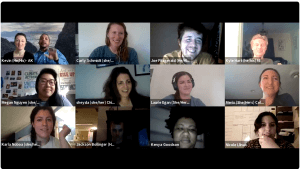
Megan, Kevin, and other participants at the Young Professionals Happy Hour during River Rally 2020.
We also work diligently through Meet Your Network interviews, other written communications, website imagery, and keynote presenter and trainer selection to lift up the work and successes of a more representative set of leaders in our network.
-
2019
2019 - A Drinking Water Guide for All
April 2019 marked the release of River Network’s Drinking Water Guide, a powerful tool for advocates and community leaders to fight for safe, clean, and affordable drinking water in their communities. In November 2019, we also released a Spanish language edition of the Guide, to increase its reach and relevance This version was adapted—not just translated—to reach the Latinx community with both culturally relevant language and aesthetics, equipping these communities with some of the tools needed to work toward change.
Hear more from Drinking Water Program Manager Sheyda Esnaashari above, and read her blog post from December 2019.
-
2020
2020 - Virtual River Rally & Pandemic Response
Recognizing the amplified need for connection and resources during the COVID-19 crisis, River Network transformed River Rally 2020 from a three-day, in-person event to a three-week, virtual experience.
As in previous years, equity, diversity, and inclusion were at the forefront of planning discussions. In 2020, this was led by the Staff EDI Committee, which questioned and pushed River Network on issues of scholarship support, accessibility, and more. We also specifically sought out and prioritized programming related to diversity, equity, and inclusion, making space for and centering these discussions.
While shifting River Rally, our team also developed Pandemic Resources, created space for discussions on addressing water shutoffs during COVID-19, and organized a series of roundtables across other relevant issues for the network.
-
2020
2020 - Making Space for Connection
During River Rally 2020, we asked attendees if they wanted opportunities post-Rally to connect regarding the role of racial justice in the movement for clean water and beyond. The answer was a resounding yes. August 2020 marked the first of these open discussions, facilitated by River Network’s Sheyda Esnaashari and 2020 Emerging Leader Megan Nguyen. The open forum, held via Zoom, allowed network members to begin working toward racial justice and create a path forward toward learning and action.
-
2020
2020 - 2020 Trends Report: Hope, With More to Do
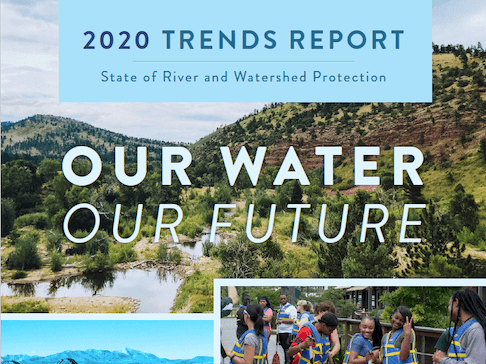 In 2020, we released a follow up to the 2016 trends report, Our Water, Our Future: State of River and Watershed Protection. The results shared that 50% of respondents believed that conditions are improving for our nation’s waterways, an increase from the just 36% who held that belief in 2016. While this represented hope and great potential for unity, the report also stressed the continued need for river and watershed protection efforts to reflect the interests and the diversity of the communities being served. While women made modest increases both overall and in senior leadership positions across the water workforce, the 2020 report found that under 10% of positions were held by Black, Indigenous, and Other People of Color (BIPOC), a number that is largely stagnant from 2016.
In 2020, we released a follow up to the 2016 trends report, Our Water, Our Future: State of River and Watershed Protection. The results shared that 50% of respondents believed that conditions are improving for our nation’s waterways, an increase from the just 36% who held that belief in 2016. While this represented hope and great potential for unity, the report also stressed the continued need for river and watershed protection efforts to reflect the interests and the diversity of the communities being served. While women made modest increases both overall and in senior leadership positions across the water workforce, the 2020 report found that under 10% of positions were held by Black, Indigenous, and Other People of Color (BIPOC), a number that is largely stagnant from 2016.
Internal Journey
-
1997
1997 - Leadership Change and First Steps for Inclusion
As River Network programming and service offerings evolved, Phil Wallin looked to step down as Executive Director and focus his work as River Network’s Director of the land transactions program. Ken Margolis, who helped found Ecotrust, took over River Network leadership in Fall 1997. At the time, River Network had multiple women on the board and staff, as well as many LGBTQ+ staff members, but was still overwhelmingly white and male. Margolis sought to change this and took steps to do so, including bringing Dianne Dillon-Ridgley and other people of color and women onto the board and staff. While proud of these first steps toward a staff and board reflective of those who depend on and care for our nation’s waters, Margolis recognizes there was more we could have done.
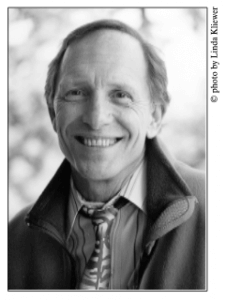
Ken Margolis.
“It’s just a fact that diversity is stronger than a lack of it; you can do more, it lasts longer, you can think more creatively… Everyone comes to the job with their own orientation, mine was protecting ecosystems, watersheds, habitat; the place I didn’t focus enough was in urban communities of color.”
-Ken Margolis
-
2005
2005 - A New Perspective as Board Chair
After joining the board in 2000, Dianne Dillon-Ridgley was Chair from 2005 to 2007. She was both the first female and the first person of color to serve as Board Chair in River Network’s history. Despite her tenure coinciding with a particularly challenging period for River Network financially and politically, diversity and inclusion was a major focus.
“I didn’t take the position of Board Chair casually, and I understood it as an opportunity and responsibility to bring together communities and concepts that at the time were too frequently thought of as separate. I wasn’t a kayaker; I was a different person to be Chair – you wanted different people to be Chair.”
-Dianne Dillon-Ridgley
-
2014
2014 - A Board Committee/Working Group and Green 2.0
After many years of discussion by the board on the need for more overt action and a position on diversity, in early 2014, board member, Baljit Wadhwa, led the creation of a Diversity Subcommittee, as an offshoot of the Governance Committee. The Subcommittee was to begin integrating the topic of diversity more formally in strategic and program planning. In spring of that year, Green 2.0 released their seminal report “The State of Diversity in Environmental Organizations: Mainstream NGOs, Foundations & Government Agencies.” The most comprehensive report on diversity in the environmental movement, it detailed a “green ceiling,” systemic biases, and lackluster interest by environmental organizations in addressing the diversity problem.
The established and dedicated Board-level Subcommittee helped make the link between the report’s findings and the work of River Network. However, it was not always a clear or easy path, with other issues competing for leadership’s prioritization. For example, the Subcommittee was reshaped to a Diversity Working Group, with the same leadership and agenda but without “committee” status. Nevertheless, over the next two years the Diversity Working Group focused first on the development of panels and speakers River Rally 2014 and 2015, followed by more strategic and long-lasting initiatives such as development of River Network’s Vision Statement on DEI and the development of a set of DEI Principles for River Network members.
“The combination of having a Diversity Committee/Working Group and the release of Green 2.0’s report on the State of Diversity in Environmental Organizations was a watershed moment for River Network too; the organization couldn’t keep avoiding the issue now.”
– Baljit Wadhwa, past River Network Board Member
-
2018
2018 - Tracking Our Progress & Training Our Staff
Starting in 2018, River Network has reported annually to our board on multiple equity, diversity, and inclusion-related metrics to hold ourselves accountable. We also submit staff demographic data to Green 2.0 and Charity Navigator, and we have tracked diversity among our staff and board through Guidestar since 2015.
Staff training has continued in earnest since 2018 as we have worked with Marcelo Bonta, the Center for Diversity and the Environment, and the Avarna Group. Our team also analyzes our programs using River Network’s Equity Assessment Tool to ensure equity is taken into account across our work.
-
2019
2019 - Formation of Staff Equity, Diversity, & Inclusion Committee
In December 2019, River Network established its first internal staff committee focused on equity, diversity, and inclusion to increase the connectivity and staff ownership of this work throughout the entire organization. Building on years of EDI work and made up of volunteer staff members, the “EDI Committee” meets twice a month to address a rolling, collaboratively built agenda across anything related to internal culture, best practices, and other elements of EDI work.
Read the River Network staff EDI Committee’s September 2020 blog post on its work to date.
-
2021
2021 - Rethinking Staff Holidays
In early 2021, members of River Network’s EDI committee reviewed and revised our employee benefits, suggesting changes that were adopted by the organization, officially recognizing holidays as part of an ongoing effort to make our work culture more inclusive.
This process was informed by many perspectives, and is at its core a step in our continued efforts to be more inclusive by acknowledging the many holidays that we often overlook, and their historical origins. As a result, 2021 was the first year we recognized Juneteenth (June 19), also known as “Freedom Day” or “Emancipation Day,” as a holiday for all River Network staff. Juneteenth commemorates the day in 1865 when Union Soldiers arrived in Galveston, Texas, and informed still-enslaved African Americans of the Emancipation Proclamation and their official freedom from slavery, two and a half years after the fact. This history has often been absent from the white dominant narrative. Recognizing Juneteenth as an official holiday is a way of acknowledging that the July 4th holiday does not tell the full story of our country’s journey toward independence.
Transparency
-
2015
2015 - Refocusing with Intentionality
After Nicole Silk joined River Network as President in 2014, we began to even more intentionally center equity, diversity, and inclusion, including among our staff. We spent significant time over these years learning about and reflecting on how issues of inclusion and equity play out within our own organization and internal culture. We engaged with outside professionals including the Avarna Group and Peter Forbes, and we shared our commitments publicly through River Voices and at River Rally.
Read the October 2015 issue of River Voices, on Diversity and Inclusiveness.
-
2017
2017 - Going Public With Our “Why”
By 2017, River Network’s Board of Directors moved forward with this statement that explains “Why Equity, Diversity, and Inclusion are the foundation of River Network’s Mission.” It was intentionally worded to encourage dialogue and we knew from the outset that it could be refined as our learning continued. Board and staff also ensured its language was open and inclusive about our intent and desire to grow in understanding with our community over time.
-
2019
2019 - Defining Inclusion
As part of our work with consultant Marcelo Bonta, he encouraged us to draft an inclusion statement. To some staff and board participants, the process initially felt superficial and unnecessary. Why spend time on word-smithing when there was so much more real and urgent work to be done? Once underway, however, the process proved invaluable, forcing us to stop and think about what inclusion truly means for River Network, identifying points of difference, and having difficult, but necessary, conversations.
“Marcelo’s facilitation helped us pinpoint, and work through, areas of
anxiety and discomfort. When we found ourselves disagreeing about word choices, we stopped to explain the reasons behind our feelings. The process became less about finding the right words and more about addressing our assumptions. Something as simple as crafting an inclusion statement led us to a sense of deeper understanding of our shared goals and values.”-Jumana Vasi, River Network Board Member
Read our definition of inclusion, and more about all our Core Values.
-
2020
2020 - Recommitting During Crisis
At the end of May 2020, during the third week of virtual River Rally, the nation erupted in response first to the racism faced by Christian Cooper while birding in Central Park, and then to the murder of George Floyd in Minnesota. River Network’s Staff EDI committee developed and published statements of solidarity and backed them up with action, creating space for open conversation during the River Rally schedule and beyond, and creating a digital library of resources for the water and conservation communities on equity, diversity, inclusion, and racial justice.
“River Network stands in solidarity with the Black community and the fight against police brutality and racial injustice in all its forms. We have committed ourselves to the fight for water equity and this necessarily includes racial equity.”
-River Network’s statement of solidarity with the Black community
Join Us for What’s Next
“We’re building an organization that can galvanize truly diverse voices to protect and restore water together, for everyone.”
Our journey is not complete. All people have a right to clean and ample water that sustains life and to achieve this right for all communities, it is imperative for the river and watershed community to build a more diverse, equitable, and inclusive movement. River Network is more committed than ever to being a catalyst and partner in this transformation.
Above, hear from River Network board member Raj Shukla on why he’s proud to serve on our board and committed to this work. And, stay tuned for where our work goes next and how you can be involved.


